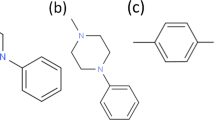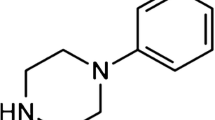Abstract
In order to study the influence of hydrogen bonding in the amide backbone of a peptide on permeability across a cell membrane, a series of tetrapeptide analogues was prepared from D-phenylalanine. The amide nitrogens in the parent oligomer were sequentially methylated to give a series containing from one to four methyl groups. The transport of these peptides was examined across confluent monolayers of Caco-2 cells as a model of the intestinal mucosa. The results of these studies showed a substantial increase in transport with each methyl group added. Only slight differences in the octanol–water partition coefficient accompanied this alkylation, suggesting that the increase in permeability is not due to lipophilicity considerations. These observations are, however, consistent with a model in which hydrogen bonding in the backbone is a principal determinant of transport. Methylation is seen to reduce the overall hydrogen bond potential of the peptide and increases flux by this mechanism. These results suggest that alkylation of the amides in the peptide chain is an effective way to improve the passive absorption potential for this class of compounds.
Similar content being viewed by others
REFERENCES
R. A. Conradi, A. R. Hilgers, N. F. H. Ho, and P. S. Burton. The influence of peptide structure on transport across Caco-2 cells. Pharm. Res. 8:1453–1460 (1991).
E. M. Wright and J. M. Diamond. Patterns of non-electrolyte permeability. Proc. Roy. Soc. B 172:227–271 (1969).
A. R. Hilgers, R. A. Conradi, and P. S. Burton. Caco-2 cell monolayers as a model for drug transport across the intestinal mucosa. Pharm. Res. 7:902–910 (1990).
I. J. Hidalgo, T. J. Raub, and R. T. Borchardt. Characterization of the human colon carcinoma cell line (Caco-2) as a model system for intestinal permeability. Gastroenterology 96:736–749 (1989).
G. Wilson, I. F. Hassan, C. J. Dix, I. Williamson, R. Shah, and M. Mackay. Transport and permeability properties of human Caco-2 cells: An in vitro model of the intestinal epithelial cell barrier. J. Control. Release 11:25–40 (1990).
P. Artursson. Epithelial transport of drugs in cell culture. I. A model for studying the passive diffusion of drugs over intestinal absorptive (Caco-2) cells. J. Pharm. Sci. 79:476–482 (1990).
N. F. H. Ho, J. Y. Park, W. Morozowich, and W. I. Higuchi. Physical model approach to the design of drugs with improved intestinal absorption. In E. R. Roche (ed.), Design of Biopharmaceutical Properties Through Prodrugs and Analogs, Am. Pharm. Assoc., Washington, DC, 1977, pp. 136–227.
W. D. Stein. The molecular basis of diffusion across cell membranes. In The Movement of Molecules Across Cell Membranes, Academic Press, New York, 1967, p. 76.
A. Leo, C. Hansch, and D. Elkins. Partition coefficients and their uses. Chem. Rev. 71:525–616 (1971).
V. Austel and E. Kutter. Absorption, distribution and metabolism of drugs. In J. G. Topliss (ed.), Quantative Structure-Activity Relationships of Drugs, Academic Press, New York, 1983, pp. 437–496.
J. M. Diamond and E. M. Wright. Biological membranes: The physical basis of ion and nonelectrolyte selectivity. Annu. Rev. Physiol. 31:581–646 (1969).
M. L. Higgins. 50 Years of hydrogen bond theory. Angew. Chem. Int. Ed. Engl. 10:147–152 (1971).
H. Susi. The strength of hydrogen bonding: Infrared spectroscopy. Methods Enzymol. 26:381–391 (1972).
R. E. Jacobs and S. H. White. The nature of hydrophobic binding of small peptides at the bilayer interface: Implications for the insertion of transbilayer helices. Biochemistry 28:3421–3437 (1989).
M. A. Roseman. Hydrophobicity of the peptide CO ·· HN hydrogen bonded group. J. Mol. Biol. 201:621–623 (1988).
T. Blundell and S. Wood. The conformation, flexibility, and dynamics of polypeptide hormones. Annu. Rev. Biochem. 51:123–154 (1982).
D. F. Sargent and R. Schwyzer. Membrane lipid phase as catalyst for peptide-receptor interactions. Proc. Natl. Acad. Sci. USA 83:5774–5778 (1986).
E. T. Kaiser and F. J. Kezdy. Amphiphilic secondary structure: Design of peptide hormones. Science 223:249–255 (1984).
Author information
Authors and Affiliations
Rights and permissions
About this article
Cite this article
Conradi, R.A., Hilgers, A.R., Ho, N.F.H. et al. The Influence of Peptide Structure on Transport Across Caco-2 Cells. II. Peptide Bond Modification Which Results in Improved Permeability. Pharm Res 9, 435–439 (1992). https://doi.org/10.1023/A:1015867608405
Issue Date:
DOI: https://doi.org/10.1023/A:1015867608405




